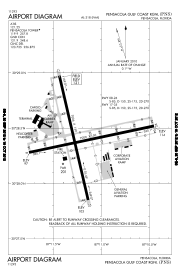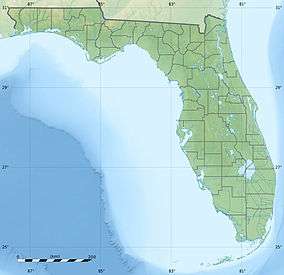Pensacola International Airport
| Pensacola International Airport | |||||||||||||||
|---|---|---|---|---|---|---|---|---|---|---|---|---|---|---|---|
 | |||||||||||||||
|
IATA: PNS – ICAO: KPNS – FAA LID: PNS – WMO: 72222 | |||||||||||||||
| Summary | |||||||||||||||
| Airport type | Public | ||||||||||||||
| Owner | City of Pensacola | ||||||||||||||
| Serves | Pensacola, Florida | ||||||||||||||
| Elevation AMSL | 121 ft / 37 m | ||||||||||||||
| Coordinates | 30°28′24″N 087°11′12″W / 30.47333°N 87.18667°WCoordinates: 30°28′24″N 087°11′12″W / 30.47333°N 87.18667°W | ||||||||||||||
| Website |
www | ||||||||||||||
| Maps | |||||||||||||||
 FAA airport diagram | |||||||||||||||
 PNS Location of airport in Florida | |||||||||||||||
| Runways | |||||||||||||||
| |||||||||||||||
| Statistics (2011) | |||||||||||||||
| |||||||||||||||
Pensacola International Airport[2] (IATA: PNS, ICAO: KPNS, FAA LID: PNS), formerly Pensacola Gulf Coast Regional Airport, is a public use airport three nautical miles (6 km) northeast of the central business district of Pensacola, in Escambia County, Florida, United States. It is owned by the City of Pensacola.[1] Despite the name, this airport does not offer direct international flights. This airport is one of the four major airports in North Florida, others being: Northwest Florida Beaches International Airport, Tallahassee International Airport, and Jacksonville International Airport.
This facility is included in the National Plan of Integrated Airport Systems, which categorized it as a primary commercial service airport.[3] As per Federal Aviation Administration records, the it had 771,917 passenger boardings (enplanements) in calendar year 2008,[4] 694,786 enplanements in 2009, and 729,748 in 2010.[5] In 2015, the airport served 1.6 million passengers.[6]
History
In 1935 a passenger terminal opened, and airline service began two years later. Atlantic and Gulf Airlines went out of business a few months later after failing to get an airmail contract. In 1938 National Airlines began flights to Mobile and Jacksonville. From 1940 to 1945, the airport was a U.S. Navy training facility; the Navy built a control tower and added a fourth runway. In 1947 Eastern Air Lines began service out of Pensacola, and in 1952 a modern terminal replaced the original one. The airport was then dedicated to L.C. Hagler, the former mayor of Pensacola. In 1968 Eastern began the first scheduled jet service from Pensacola.
In 1978, after deregulation of the airline industry, several airlines tried Pensacola, including Continental and Delta. In 1978 a National Airlines Boeing 727 crashed into Escambia Bay while on approach for landing, the first fatal airline accident in the area. In 1979 US Airways, then called USAir, arrived at Pensacola. In 1990 the current terminal was built and AirTran Airways began jet service. In 2005 United Express began service out of Pensacola.
Pensacola mayor Ashton Hawyard announced on November 9, 2011 that, despite not serving any international destinations, the airport would change its name from Pensacola Gulf Coast Regional Airport to Pensacola International Airport effective immediately.[7]
Facilities and aircraft
Pensacola International Airport covers an area of 1,211 acres (490 ha) at an elevation of 121 feet (37 m) above mean sea level. It has two runways: 8/26 is 7,000 by 150 feet (2,134 x 46 m) with an asphalt surface; 17/35 is 7,004 by 150 feet (2,135 x 46 m) with a concrete surface.[1]
Runway 17 has an instrument landing system and approach lights, while the Runway 26 approach has a localizer approach. A 1,000 ft. extension to the east end of Runway 8/26 was completed in 2006. The airport hopes to extend Runway 17/35 to about 8,500 ft.
The airport's two war-era diagonal runways were decommissioned in the 1960s.
For the 12-month period ending December 31, 2011, the airport had 117,053 aircraft operations, an average of 320 per day: 53% general aviation, 21% military, 18% air taxi, and 8% scheduled commercial. At that time there were 85 aircraft based at this airport: 69% single-engine, 21% multi-engine, 6% jet, and 4% helicopter.[1]
The most common aircraft used by the airlines is the ERJ-145 on American Eagle and United Express. The much larger MD-80 series aircraft used by American and Delta is the second most common. The 737 aircraft used by Southwest Airlines is the third. The smaller SF-34 propeller aircraft used by Silver Airways is the fifth. The UPS A300-600 is the sixth and the only wide body aircraft to regularly come to Pensacola. Delta seasonally operates the Airbus A319, A320, the Boeing 757-200 and occasionally the Boeing 737 series.
Terminal
Pensacola has one passenger terminal with 12 gates, built in the early 1990s. Gates 1 through 10 are located on the 2nd floor, while Gates 11 and 12 are located on the ground floor.
Gate assignments:
- American: 5, 6, 7
- Delta: 2, 4
- Silver: 1
- Southwest: 10
- United: 3, 9
Gate 8 is an open gate that is used by charter flights, diversions, or any airline that needs to use another gate.
Terminal expansion
The terminal was expanded in 2011 at a cost of $35 million. The expansion was designed by Gresham, Smith and Partners[8] and Stoa Architects.[9][10]
Management
The interim airport director is Daniel Flynn.[11] The airport is a department of the city of Pensacola.[11]
Airlines and destinations
Passenger
Statistics
Top destinations
| Rank | City | Passengers | Carriers |
|---|---|---|---|
| 1 | Atlanta, Georgia | 328,000 | Delta |
| 2 | Dallas/Fort Worth, Texas | 99,000 | American |
| 3 | Charlotte, North Carolina | 77,000 | American/US Airways |
| 4 | Houston–Intercontinental, Texas | 67,000 | United |
| 4 | Nashville, Tennessee | 63,000 | Southwest |
| 6 | Miami, Florida | 41,000 | American |
| 7 | Houston–Hobby, Texas | 34,000 | Southwest |
| 8 | Orlando, Florida | 16,000 | Silver Airways |
| 9 | Tampa, Florida | 15,000 | Silver Airways |
| 10 | Chicago–O'Hare, Illinois | 10,000 | United |
Statistics
| Carrier | Passengers (arriving and departing) |
|---|---|
| Delta | 643,000(42.49%) |
| Southwest | 219,000(14.47%) |
| ExpressJet | 150,000(9.91%) |
| Envoy | 146,000(9.64%) |
| Mesa | 97,490(6.45%) |
| Other | 258,000(17.05%) |
Cargo airlines
UPS Airlines is the only major cargo carrier at the airport currently. UPS flies 2 flights into Pensacola, 4 days out of the week, Tuesday through Friday. On Saturday, UPS only flies one flight to Pensacola. Suburban Air Freight operates daily flights to Atlanta with a Beech 1900C. Ameriflight operated daily feeder flights for UPS to Mobile Downtown Airport and Gulfport International Airport with the Swearingen Fairchild SA227-AT Metro until July 16, 2016. As of July 18, 2016, Martinaire took over feeder service from Ameriflight with the Cessna 208B Super Cargomaster.
| Airlines | Destinations |
|---|---|
| UPS Airlines | Albany (GA), Louisville, New Orleans |
| Suburban Air Freight | Atlanta |
| Martinaire | Mobile Downtown Airport, Gulfport International Airport. |
Accidents and incidents
On May 8, 1978 National Airlines Flight 193 landed in Escambia Bay while approaching the east-west runway. Three of the 58 passengers and crew on board were killed.
On December 27, 1987 an Eastern Airlines DC-9-31 made a hard landing and split its fuselage open just aft of its wing root. No one was seriously injured[13] in the accident but the aircraft was written off.[14]
On July 6, 1996, Delta Air Lines Flight 1288, an MD-88, experienced an uncontained engine failure during takeoff on runway 17. Fragments from the number one (left) Pratt & Whitney JT8D-219 turbofan engine penetrated the fuselage, killing two and seriously injuring one of the 148 people on board.
On August 27, 2016, Southwest Airlines flight 3472, a Boeing 737-700 flying from New Orleans to Orlando with 104 persons on board, suffered an uncontained engine failure while climbing to cruise altitude over the Gulf of Mexico. The debris punctured the fuselage, which caused the cabin to depressurize. The captain diverted the flight to Pensacola, where it landed safely and uneventfully 10 minutes later. There were no fatalities or injuries.[15]
References
- 1 2 3 4 FAA Airport Master Record for PNS (Form 5010 PDF). Federal Aviation Administration. Effective November 15, 2012.
- ↑ Pensacola International Airport
- ↑ "2011–2015 NPIAS Report, Appendix A" (PDF, 2.03 MB). faa.gov. Federal Aviation Administration. October 4, 2010.
- ↑ "Enplanements for CY 2008" (PDF, 1.0 MB). faa.gov. Federal Aviation Administration. December 18, 2009.
- ↑ "Enplanements for CY 2010" (PDF, 189 KB). faa.gov. Federal Aviation Administration. October 4, 2011.
- ↑ "Pensacola International Airport". www.flypensacola.com. Retrieved 2016-02-16.
- ↑ http://www.flypensacola.com/_files/contents/386/Airport%20Event%20110911.pdf
- ↑ Pensacola International Airport – Gresham Smith
- ↑ Pensacola Gulf Coast Regional Airport – Stoa Architects
- ↑ http://flypensacola.com/upload/images/pdfs/AirExpan2007_new.pdf
- 1 2 http://www.flypensacola.com/page/AboutAirport
- 1 2 http://www.transtats.bts.gov/airports.asp?pn=1&Airport=PNS&Airport_Name=Pensacola,%20FL:%20Jacksonville%20International&carrier=FACTS
- ↑ Eastern Jet's fuselage cracks wide open during bumpy landing in Pensacola
- ↑ Aircraft McDonnell Douglas DC-9-31 N8948E Pensacola Regional Airport
- ↑ "Accident: Southwest B737 near Pensacola on Aug 27th 2016, uncontained engine failure". The Aviation Herald. 2016-08-27. Retrieved 2016-09-01.
External links
- Pensacola International Airport, official site
- Aerial image as of November 1999 from USGS The National Map
- FAA Airport Diagram (PDF), effective November 10, 2016
- FAA Terminal Procedures for PNS, effective November 10, 2016
- Resources for this airport:
- AirNav airport information for KPNS
- ASN accident history for PNS
- FlightAware airport information and live flight tracker
- NOAA/NWS latest weather observations
- SkyVector aeronautical chart for KPNS
- FAA current PNS delay information
